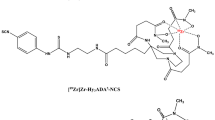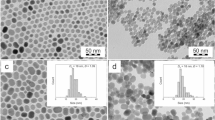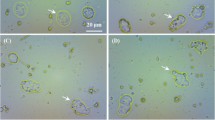Abstract
Feraheme (FH) nanoparticles (NPs) have been used extensively for treatment of iron anemia (due to their slow release of ionic iron in acidic environments). In addition, injected FH NPs are internalized by monocytes and function as MRI biomarkers for the pathological accumulation of monocytes in disease. We have recently expanded these applications by radiolabeling FH NPs for positron emission tomography (PET) or single-photon emission computed tomography (SPECT) imaging using a heat-induced radiolabeling (HIR) strategy. Imaging FH NPs using PET/SPECT has important advantages over MRI due to lower iron doses and improved quantitation of tissue NP concentrations. HIR of FH NPs leaves the physical and biological properties of the NPs unchanged and allows researchers to build on the extensive knowledge obtained about the pharmacokinetic and safety aspects of FH NPs. In this protocol, we present the step-by-step procedures for heat (120 °C)-induced bonding of three widely employed radiocations (89Zr4+ or 64Cu2+ for PET, and 111In3+ for SPECT) to FH NPs using a chelateless radiocation surface adsorption (RSA) approach. In addition, we describe the conversion of FH carboxyl groups into amines and their reaction with an N-hydroxysuccinimide (NHS) of a Cy5.5 fluorophore. This yields Cy5.5-FH, a fluorescent FH that enables the cells internalizing Cy5.5-FH to be examined using flow cytometry. Finally, we describe procedures for in vivo and ex vivo uptake of Cy5.5-FH by monocytes and for in vivo microPET/CT imaging of HIR-FH NPs. Synthesis of HIR-FH requires experience with working with radioactive cations and can be completed within <4 h. Synthesis of Cy5.5-FH NPs takes ∼17 h.
This is a preview of subscription content, access via your institution
Access options
Access Nature and 54 other Nature Portfolio journals
Get Nature+, our best-value online-access subscription
$29.99 / 30 days
cancel any time
Subscribe to this journal
Receive 12 print issues and online access
$259.00 per year
only $21.58 per issue
Buy this article
- Purchase on Springer Link
- Instant access to full article PDF
Prices may be subject to local taxes which are calculated during checkout





Similar content being viewed by others
References
Coyne, D.W. Ferumoxytol for treatment of iron deficiency anemia in patients with chronic kidney disease. Expert Opin. Pharmacother. 10, 2563–2568 (2009).
Auerbach, M., Strauss, W., Auerbach, S., Rineer, S. & Bahrain, H. Safety and efficacy of total dose infusion of 1,020 mg of ferumoxytol administered over 15 min. Am. J. Hematol. 88, 944–947 (2013).
Bashir, M.R., Bhatti, L., Marin, D. & Nelson, R.C. Emerging applications for ferumoxytol as a contrast agent in MRI. J. Magn. Reson. Imaging 41, 884–898 (2015).
Farrell, B.T. et al. Using iron oxide nanoparticles to diagnose CNS inflammatory diseases and PCNSL. Neurology 81, 256–263 (2013).
Hamilton, B.E. et al. Comparative analysis of ferumoxytol and gadoteridol enhancement using T1- and T2-weighted MRI in neuroimaging. Am. J. Roentgenol. 197, 981–988 (2011).
McCullough, B.J., Kolokythas, O., Maki, J.H. & Green, D.E. Ferumoxytol in clinical practice: implications for MRI. J. Magn. Reson. Imaging 37, 1476–1479 (2013).
Chen, F. et al. Chelator-free synthesis of a dual-modality PET/MRI agent. Angew. Chem. Int. Ed. Engl. 52, 13319–13323 (2013).
Shi, S. et al. Chelator-free radiolabeling of nanographene: breaking the stereotype of chelation. Angew. Chem. Int. Ed. Engl. 56, 2889–2892 (2017).
Freund, B. et al. A simple and widely applicable method to 59Fe-radiolabel monodisperse superparamagnetic iron oxide nanoparticles for in vivo quantification studies. ACS Nano 6, 7318–7325 (2012).
Israel, L.L. et al. Surface metal cation doping of maghemite nanoparticles: modulation of MRI relaxivity features and chelator-free 68 Ga-radiolabelling for dual MRI-PET imaging. Mater. Res. Express 2, 095009 (2015).
Gaglia, J.L. et al. Noninvasive mapping of pancreatic inflammation in recent-onset type-1 diabetes patients. Proc. Natl. Acad. Sci. USA 112, 2139–2144 (2015).
Yilmaz, A. et al. Imaging of myocardial infarction using ultrasmall superparamagnetic iron oxide nanoparticles: a human study using a multi-parametric cardiovascular magnetic resonance imaging approach. Eur. Heart J. 34, 462–475 (2013).
Hasan, D.M. et al. Macrophage imaging within human cerebral aneurysms wall using ferumoxytol-enhanced MRI: a pilot study. Arterioscler. Thromb. Vasc. Biol. 32, 1032–1038 (2012).
Chalouhi, N., Jabbour, P. & Hasan, D. Inflammation, macrophages, and targeted imaging in intracranial aneurysms. World Neurosurg. 81, 206–208 (2014).
Vellinga, M.M. et al. Use of ultrasmall superparamagnetic particles of iron oxide (USPIO)-enhanced MRI to demonstrate diffuse inflammation in the normal-appearing white matter (NAWM) of multiple sclerosis (MS) patients: an exploratory study. J. Magn. Reson. Imaging 29, 774–779 (2009).
Maarouf, A. et al. Ultra-small superparamagnetic iron oxide enhancement is associated with higher loss of brain tissue structure in clinically isolated syndrome. Mult. Scler. 22, 1032–1039 (2016).
Usman, A. et al. Use of ultrasmall superparamagnetic iron oxide particles for imaging carotid atherosclerosis. Nanomedicine (Lond.) 10, 3077–3087 (2015).
Boros, E., Bowen, A.M., Josephson, L., Vasdev, N. & Holland, J.P. Chelate-free metal ion binding and heat-induced radiolabeling of iron oxide nanoparticles. Chem. Sci. 6, 225–236 (2015).
Normandin, M.D. et al. Heat-induced radiolabeling of nanoparticles for monocyte tracking by PET. Angew. Chem. Int. Ed. Engl. 54, 13002–13006 (2015).
Sîrbulescu, R.F. et al. Mature B cells accelerate wound healing after acute and chronic diabetic skin lesions. Wound Repair Regen. 25, 774–791. (2017).
Yuan, H. et al. Heat-induced-radiolabeling and click chemistry: a powerful combination for generating multifunctional nanomaterials. PLoS One 12, e0172722 (2017).
Balakrishnan, V.S. et al. Physicochemical properties of ferumoxytol, a new intravenous iron preparation. Eur. J. Clin. Invest. 39, 489–496 (2009).
Jahn, M.R. et al. A comparative study of the physicochemical properties of iron isomaltoside 1000 (Monofer), a new intravenous iron preparation and its clinical implications. Eur. J. Pharm. Biopharm. 78, 480–491 (2011).
Futterer, S., Andrusenko, I., Kolb, U., Hofmeister, W. & Langguth, P. Structural characterization of iron oxide/hydroxide nanoparticles in nine different parenteral drugs for the treatment of iron deficiency anaemia by electron diffraction (ED) and X-ray powder diffraction (XRPD). J. Pharm. Biomed. Anal. 86, 151–160 (2013).
Groman, E.V., Paul, K.G., Frigo, T.B., Bengele, H. & Lewis, J.M. Heat stable colloidal iron oxides coated with reduced carbohydrates and derivatives. US patent 6,599,498 (2003).
Maruno, S. et al. Polysaccharide derivative/magnetic metal oxide composite. US patent 6,165,378 (2000).
Maruno, S. & Hasegawa, M. Organic matter complex. US patent 5,204,457 (1993).
Alcantara, D. et al. Fluorochrome-functionalized magnetic nanoparticles for high-sensitivity monitoring of the polymerase chain reaction by magnetic resonance. Angew. Chem. Int. Ed. Engl. 51, 6904–6907 (2012).
Cho, H. et al. Fluorochrome-functionalized nanoparticles for imaging DNA in biological systems. ACS Nano 7, 2032–2041 (2013).
Warner, C.L. et al. Manganese doping of magnetic iron oxide nanoparticles: tailoring surface reactivity for a regenerable heavy metal sorbent. Langmuir 28, 3931–3937 (2012).
Chakravarty, R., Goel, S., Dash, A. & Cai, W. Radiolabeled inorganic nanoparticles for positron emission tomography imaging of cancer: an overview. Q. J. Nucl. Med. Mol. Imaging 61, 181–204 (2017).
Sun, X., Cai, W. & Chen, X. Positron emission tomography imaging using radiolabeled inorganic nanomaterials. Acc. Chem. Res. 48, 286–294 (2015).
Goel, S., Chen, F., Ehlerding, E.B. & Cai, W. Intrinsically radiolabeled nanoparticles: an emerging paradigm. Small 10, 3825–3830 (2014).
Wunderbaldinger, P., Josephson, L., Bremer, C., Moore, A. & Weissleder, R. Detection of lymph node metastases by contrast-enhanced MRI in an experimental model. Magn. Reson. Med. 47, 292–297 (2002).
Thorek, D.L. et al. Non-invasive mapping of deep-tissue lymph nodes in live animals using a multimodal PET/MRI nanoparticle. Nat. Commun. 5, 3097 (2014).
Keliher, E.J. et al. 89Zr-labeled dextran nanoparticles allow in vivo macrophage imaging. Bioconjug. Chem. 22, 2383–2389 (2011).
Weissleder, R. et al. Superparamagnetic iron oxide: pharmacokinetics and toxicity. Am. J. Roentgenol. 152, 167–173 (1989).
Wong, R.M., Gilbert, D.A., Liu, K. & Louie, A.Y. Rapid size-controlled synthesis of dextran-coated, 64Cu-doped iron oxide nanoparticles. ACS Nano 6, 3461–3467 (2012).
Liu, K.X. et al. Controllable preparation of ternary superparamagnetic nanoparticles dual-doped with Mn and Zn elements. J. Nanosci. Nanotechnol. 12, 8437–8442 (2012).
Chen, S., Alcantara, D. & Josephson, L. A magnetofluorescent nanoparticle for ex vivo cell labeling by covalently linking the drugs protamine and Feraheme. J. Nanosci. Nanotechnol. 11, 3058–3064 (2011).
Lu, M., Cohen, M.H., Rieves, D. & Pazdur, R. FDA report: ferumoxytol for intravenous iron therapy in adult patients with chronic kidney disease. Am. J. Hematol. 85, 315–319 (2010).
Wang, C. et al. Comparative risk of anaphylactic reactions associated with intravenous iron products. JAMA 314, 2062–2068 (2015).
Ning, P., Zucker, E.J., Wong, P. & Vasanawala, S.S. Hemodynamic safety and efficacy of ferumoxytol as an intravenous contrast agents in pediatric patients and young adults. Magn. Reson. Imaging 34, 152–158 (2016).
Finn, J.P. et al. Cardiovascular MRI with ferumoxytol. Clin. Radiol. 71, 796–806 (2016).
Gahart, B.L., Nazareno, A.R. & Ortega, M.Q. Intravenous Medications: A Handbook for Nurses and Health Professionals 3rd edn 555–556 (Elsevier, 2016).
Lacroute, P. & Levoy, M. Fast volume rendering using a shear-warp factorization of the viewing transformation. Computer Graphics Proceedings, Annual Conference Series, 451. (1994).
Bar-Shalom, R. et al. SPECT/CT using 67Ga and 111In-labeled leukocyte scintigraphy for diagnosis of infection. J. Nucl. Med. 47, 587–594 (2006).
Lou, L. et al. 99mTc-WBC scintigraphy with SPECT/CT in the evaluation of arterial graft infection. Nucl. Med. Commun. 31, 411–416 (2010).
Schnell, M.A., Hardy, C., Hawley, M., Propert, K.J. & Wilson, J.M. Effect of blood collection technique in mice on clinical pathology parameters. Hum. Gen. Ther. 13, 155–161 (2002).
Harisinghani, M., Ross, R.W., Guimaraes, A.R. & Weissleder, R. Utility of a new bolus-injectable nanoparticle for clinical cancer staging. Neoplasia 9, 1160–1165 (2007).
Turkbey, B. et al. A phase I dosing study of ferumoxytol for MR lymphography at 3 T in patients with prostate cancer. Am. J. Roentgenol. 205, 64–69 (2015).
Acknowledgements
This study was supported by grants NIH R01 EB017699, NIH T32EB013180, and NIH R01 MH100350.
Author information
Authors and Affiliations
Contributions
L.J. conceived of the HIR strategy and conducted synthetic and analytical experiments. H.Y. synthesized and analyzed all materials, and developed all analytical methods. M.Q.W., C.K., and M.D.N. performed in vivo imaging and flow cytometry studies. G.E.F. and L.J. analyzed data and wrote the manuscript.
Corresponding author
Ethics declarations
Competing interests
The authors declare no competing financial interests.
Integrated supplementary information
Supplementary Figure 1 Gating strategy for flow cytometry data.
Representative gating strategy for excluding doublets (a), and debris (b) in flow cytometry analysis of 1×10^6 events. Singlets are defined on the Forward-Scatter(height) vs. Forward-Scatter(area) dot plot (a). Singlets comprise 84.35% of total events in this data set. Small debris are excluded on a Side-Scatter(Area) vs. Forward-Scatter(Area) dot plot (b). Debris comprise 78.75% of all events in this data set. The data that was shown previously and that was used for analysis was those events that were non-debris singlets. In this data set, the non-debris singlet populations comprised 16.52% of all events.
Supplementary information
Supplementary Figure 1
Gating strategy for flow cytometry data. (PDF 336 kb)
3D video
3D video of animal shown in Figure 6. (MPG 970 kb)
Rights and permissions
About this article
Cite this article
Yuan, H., Wilks, M., Normandin, M. et al. Heat-induced radiolabeling and fluorescence labeling of Feraheme nanoparticles for PET/SPECT imaging and flow cytometry. Nat Protoc 13, 392–412 (2018). https://doi.org/10.1038/nprot.2017.133
Published:
Issue Date:
DOI: https://doi.org/10.1038/nprot.2017.133
This article is cited by
-
Simultaneous quantitative imaging of two PET radiotracers via the detection of positron–electron annihilation and prompt gamma emissions
Nature Biomedical Engineering (2023)
-
Positron annihilation localization by nanoscale magnetization
Scientific Reports (2020)
-
FDA-approved ferumoxytol displays anti-leukaemia efficacy against cells with low ferroportin levels
Nature Nanotechnology (2019)
-
Assessing the interactions between radiotherapy and antitumour immunity
Nature Reviews Clinical Oncology (2019)
-
Radio-enhancement effects by radiolabeled nanoparticles
Scientific Reports (2019)
Comments
By submitting a comment you agree to abide by our Terms and Community Guidelines. If you find something abusive or that does not comply with our terms or guidelines please flag it as inappropriate.




